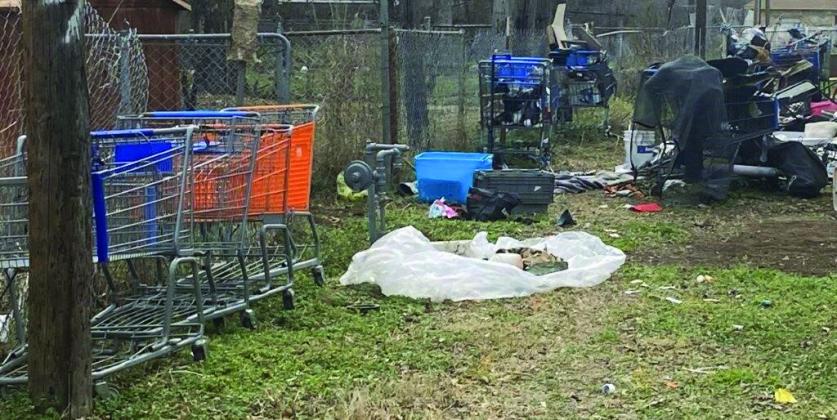LAWTON – Abandoned shopping carts were discussed at length recently during the first meeting of the Homeless Action Committee, because the carts are “an after-effect of homelessness,” City Councilman Kelly Harris said.
Harris mentioned a location in his Ward 2 where 18 shopping carts were parked in an alley, and a photo he snapped of a woman pushing a Walmart cart full of groceries to her home, where she had four more carts.
The City Council on March 26 amended an ordinance, effective April 25, that as a general rule prohibits scrap dealers from buying bicycles, lawn mowers, metal fencing, metal real estate signs, trailers such as boat trailers and shopping carts.
Harris focused on shopping carts after he investigated and learned that the managers of all three Walmart stores in Lawton have to replace scores of shopping carts – at a cost of $239 apiece – “on a regular basis.” He said the manager of the Walmart Neighborhood Market at 38th Street and Lee Boulevard told him they lost 100 grocery carts in three months.
Shopping carts are being filled with stolen and discarded property and abandoned at various locations, including an alley in the vicinity of 18th and Kingsbury, he told Southwest Ledger.
Lawton Police Sgt. Matt Dimmitt told the committee that officers found 23 shopping carts in one driveway, “and one day we found over 60 carts in one trash dumpster.” In addition, “We’re getting tons of them out of waterways,” he said.
For instance, early this year several city employees were called to clean out a homeless encampment along a creek behind the Walmart Supercenter at 1002 NW Sheridan Road, north of Ferris Avenue. Three tons of trash and debris were removed – along with some shopping carts, Dimmitt reported.
During the June 27 meeting, Assistant City Attorney Garrett Lam pointed to an ordinance adopted in Torrance, California, which requires all businesses that have 10 or more shopping carts to submit a “Shopping Cart Retrieval and Containment Plan” to the municipal Community Development Department. They also are required to affix identification to each of their carts.
“One area of continued blight has been abandoned shopping carts,” the City of Torrance declared. “Shopping carts removed without authorization often end up abandoned on roadways, along sidewalks and in our parks.” Abandoned carts contribute to blight and “businesses are also impacted through the loss of their asset.”
The City of Torrance is empowered to sell or otherwise dispose of any shopping carts that are not reclaimed within 30 days after the date of notice that they have been impounded.
Lawton City Attorney John Andrew mentioned the approach taken by the City of Paterson, New Jersey.
Paterson’s regulations decree that the “unauthorized removal” of shopping carts from retail establishments “constitutes a nuisance, creates potential hazards to the health and safety of the public, and interferes with pedestrian and vehicular traffic.” The accumulation of wrecked, dismantled, and abandoned shopping carts on public and/or private property “creates conditions that reduce property values and promote blight and neighborhood deterioration within the city.”
Shopping carts must be “contained … on the business premises at all times” unless the cart is taken away for maintenance/repair, or a customer “possesses express written authorization from the cart owner” to remove it from the premises, and then for no more than 72 hours.
Also, every cart owner “shall operate and maintain” a shopping cart containment plan that has all of the following provisions:
• The name of the business owner and its physical address, and the name, address and phone number(s) if different from the business owner.
• A complete inventory of carts maintained on or in the business premises.
• A description of the specific measures that the cart owner must implement to prevent removal of shopping carts from the business premises.
Those measures may include installation of electronic disabling devices, such as wheel locks that disable the cart upon crossing a barrier at the perimeter of the business premises.
Those devices cost approximately $100 each and are affixed to grocery carts at Lawton’s two Homeland grocery stores, Harris said. The wheels lock up “at the door if the customer doesn’t pay for his/her groceries” or if the cart attempts to cross an electronic threshold, the councilman said, and a special key is required to unlock the wheel.
Shopping carts at Ross Dress for Less in Lawton, and at dd’s Discounts, are equipped with tall poles that prevent the carts from passing beyond the stores’ entrance/exit doors, Harris said.
In the event the City of Paterson retrieves a shopping cart, the city must notify the cart owner or the responsible party and relate the location of the shopping cart(s) and how the cart(s) can be retrieved. A retailer who doesn’t retrieve his shopping cart(s) can be fined by the city.
The Lawton Police Department would have trouble proving theft of a shopping cart, but “the individual could be prosecuted” for unauthorized use of a cart, Dimmitt said.
City Manager John Ratliff suggested “perhaps we could make it a zoning issue.” For example, shopping carts found in any area zoned R1 (residential) could be declared a nuisance.
Someone suggested using an incentive, rather than a punitive measure, for redeeming abandoned shopping carts. Soft drink companies used to pay a few cents for any glass “pop” bottles that were returned to grocery stores, Councilman Allan Hampton recalled.
A quick check online found shopping carts priced from $105 apiece to $1,080 each.
Responsibility for retrieval of abandoned shopping carts – by the Neighborhood Services Division, the Police Department, or perhaps by code enforcement officers – was discussed, but no definitive solution was reached.
Another unresolved issue is where abandoned shopping carts that are recovered would be stored until such time as they were retrieved by the owners or sold as scrap metal.


